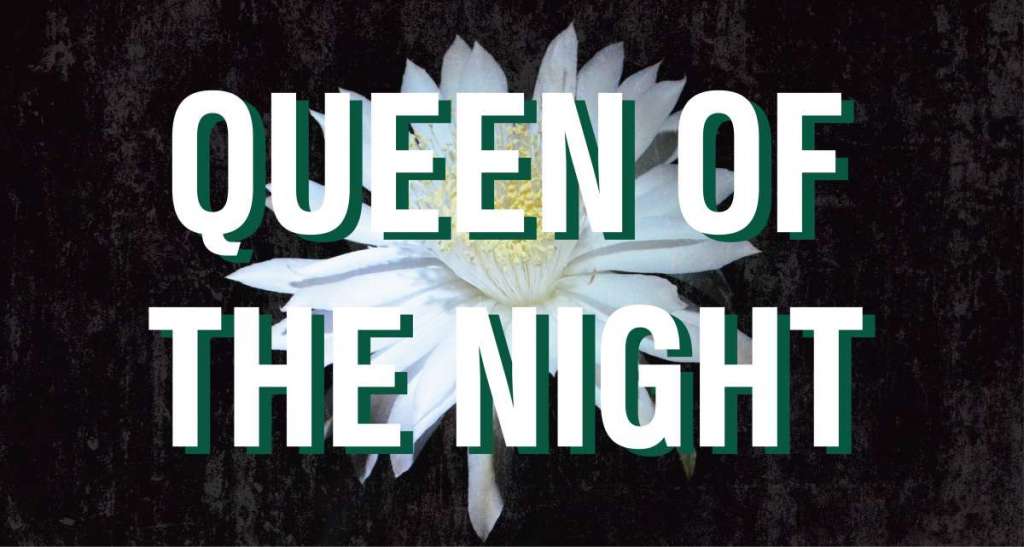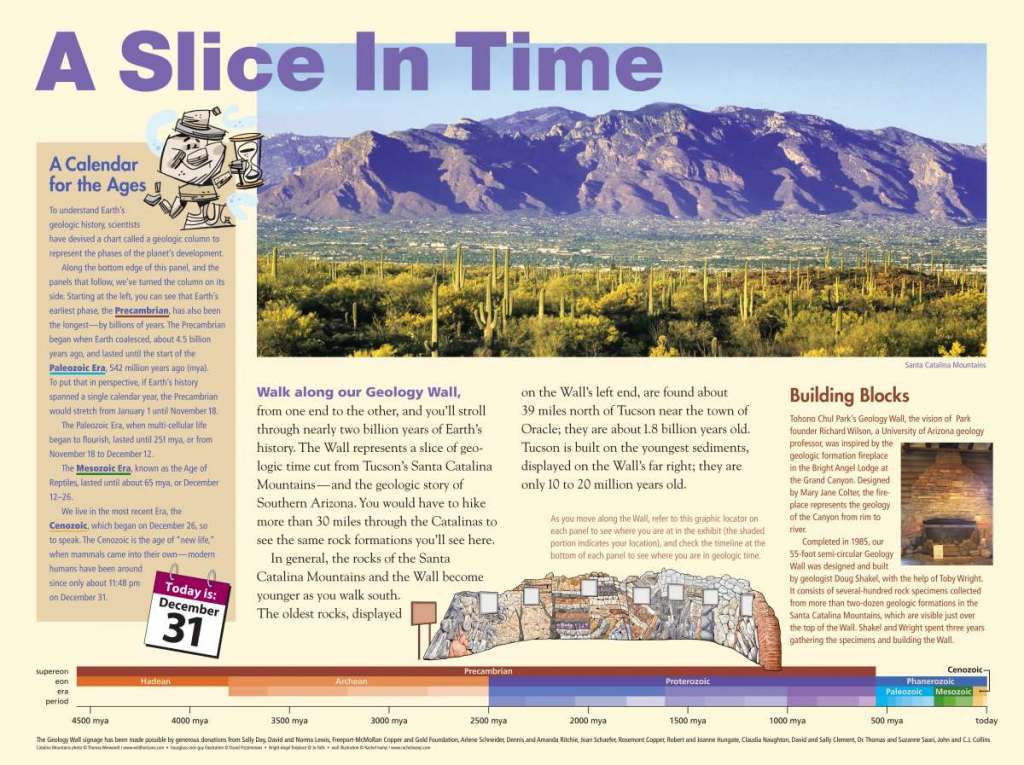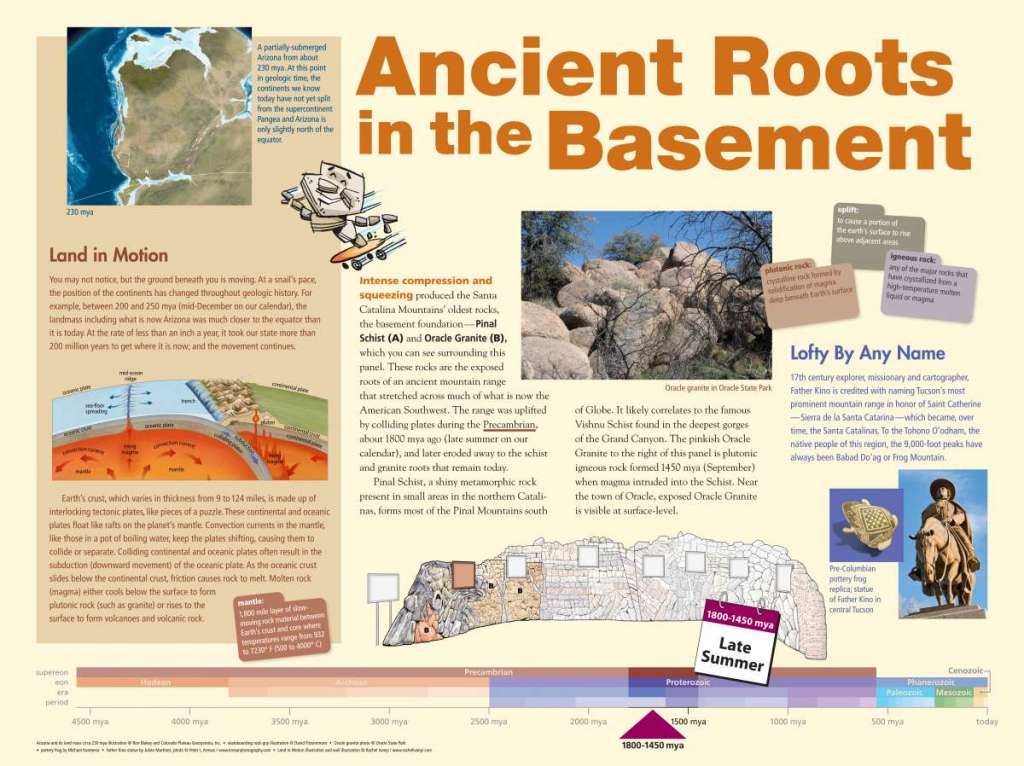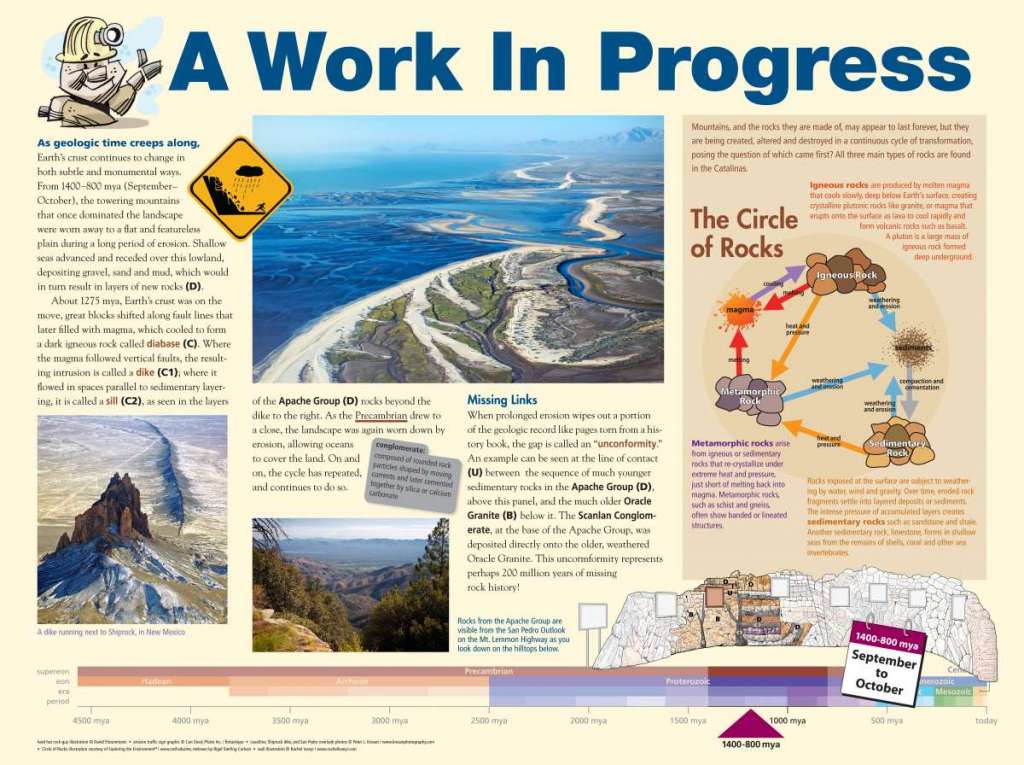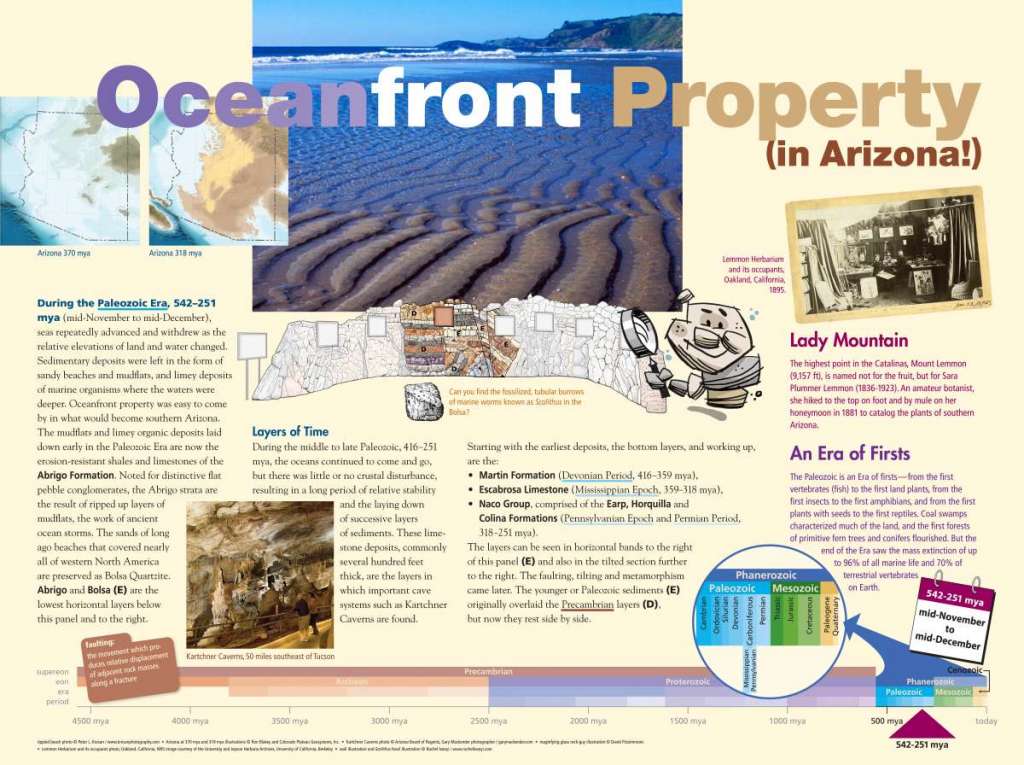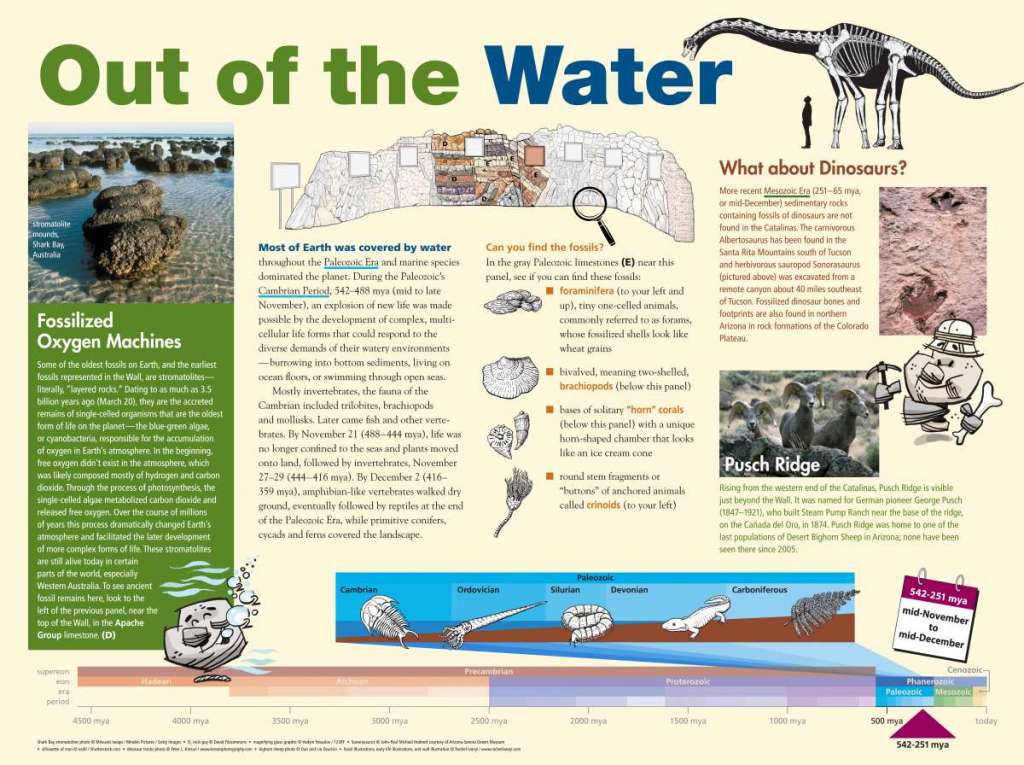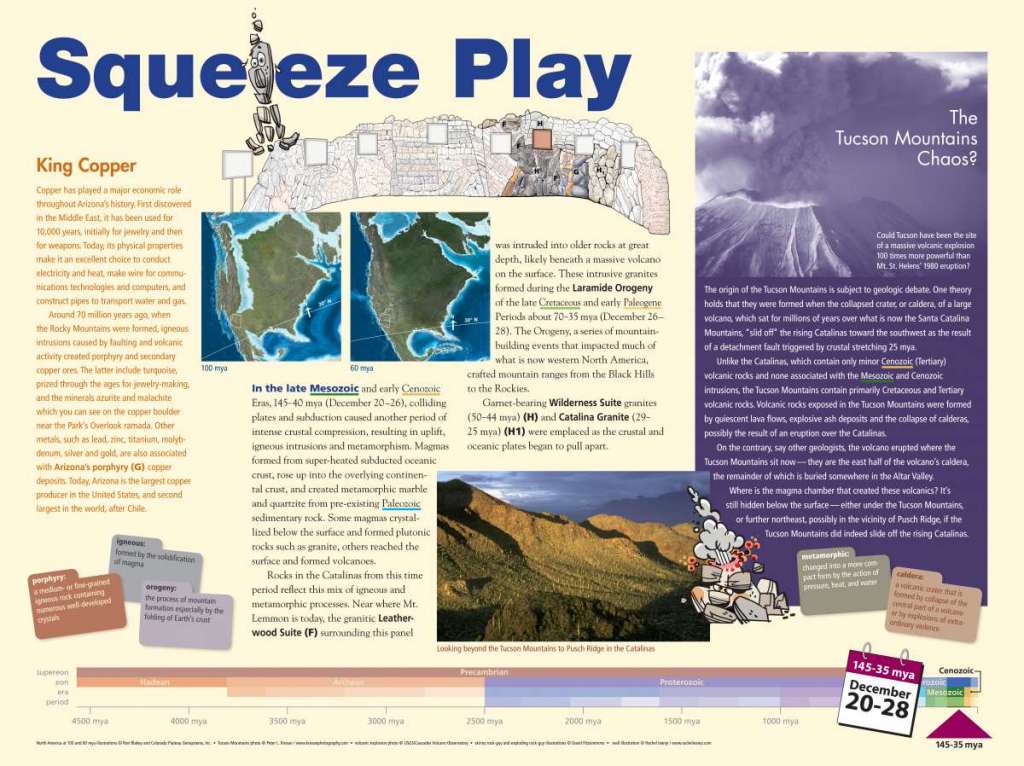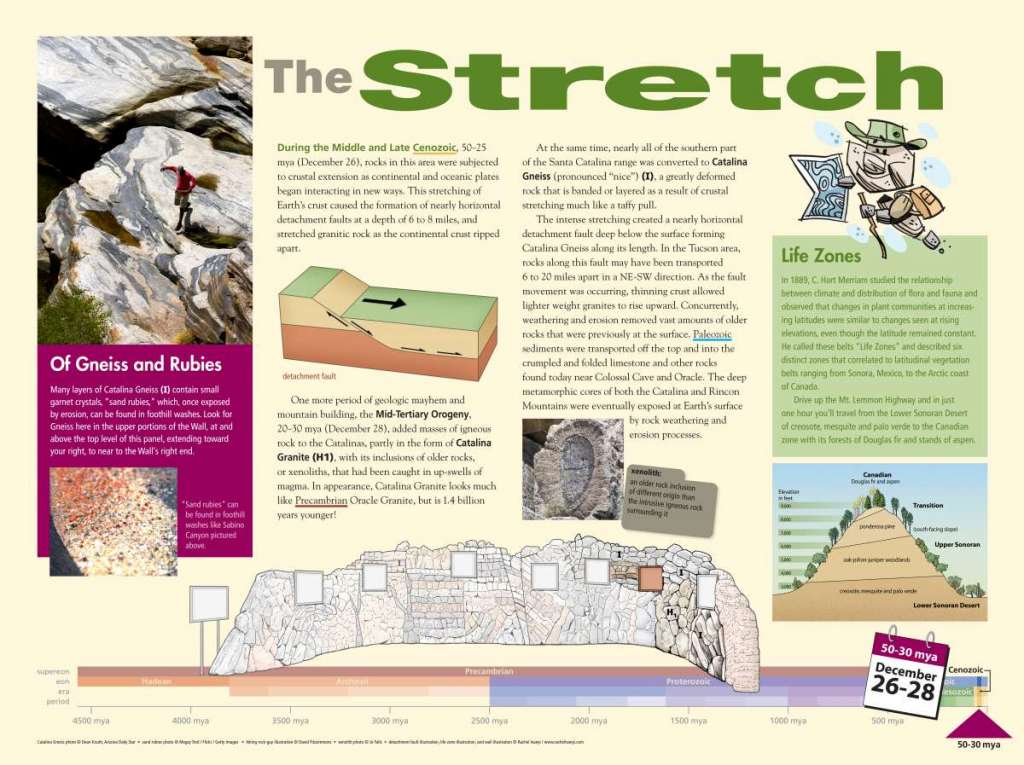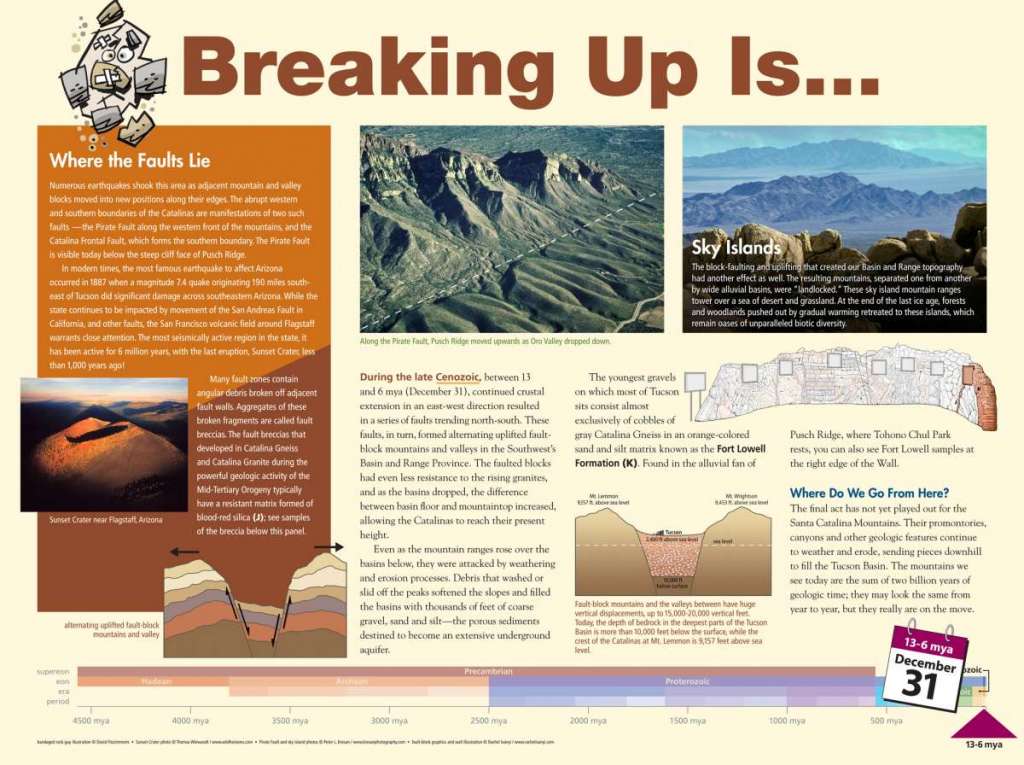Day 1 – The Geology Wall
Unique in all of Tucson, if not the world, is Tohono Chul’s Geology Wall exhibit. The idea of founder Richard Wilson, a geology professor with the University of Arizona, and built by geologist Doug Shakel and Toby Wright, the 55 foot long, semi-circular wall consists of several hundred rock specimens that represent the more than two dozen geologic formations that comprise the 9,000-foot Santa Catalina Mountains, visible just over the top of the wall itself. As you proceed along the Wall from left to right, you are walking through nearly two billion years of the Earth’s history! In general, the rocks of the Catalinas (and the Wall) become younger and younger as you proceed southward. Thus Tucson is built on the youngest rocks, displayed on the far right. The oldest are displayed on the far left and would be found north of Tucson near the town of Oracle.
Click on the images to learn from our interpretive signs
Rockstar Activities
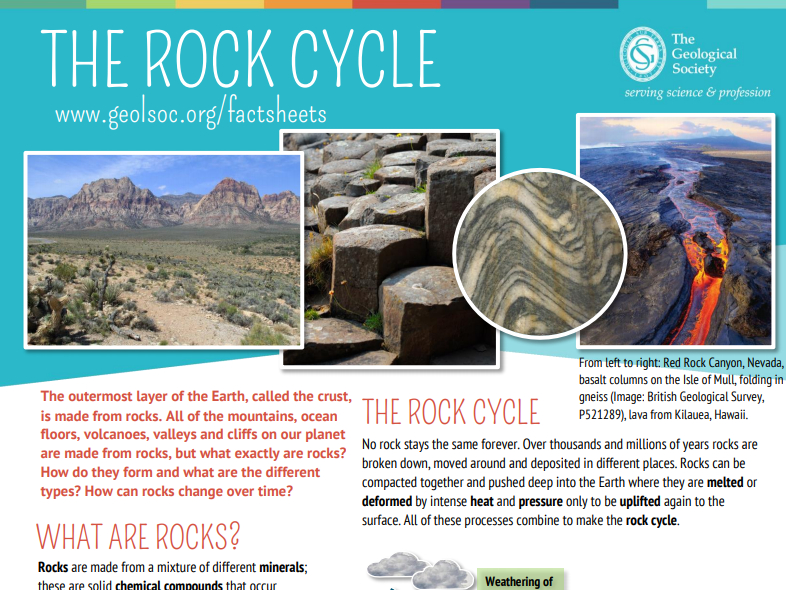
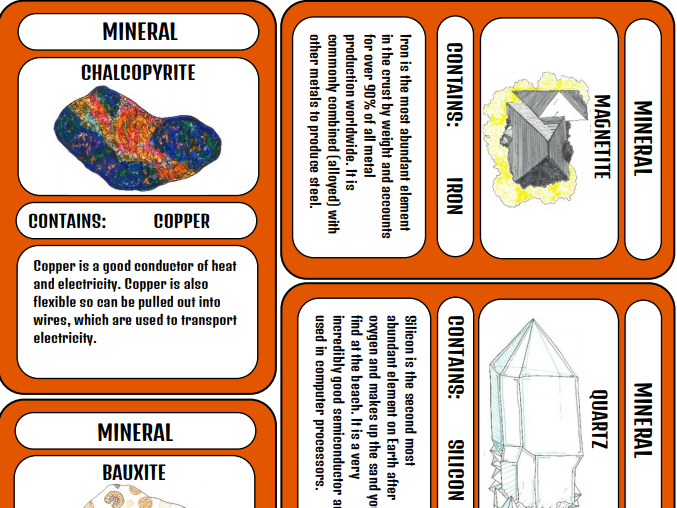
More Than Rocks
Fossils
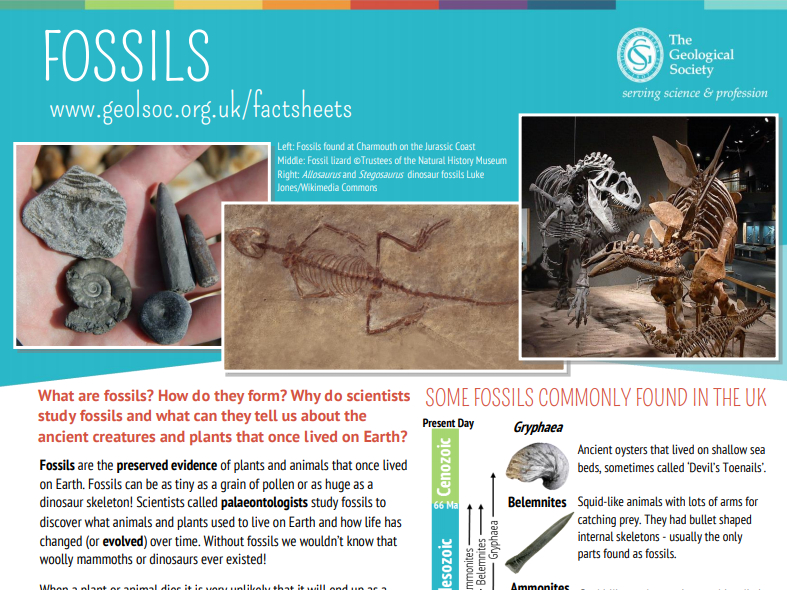
Volcanoes
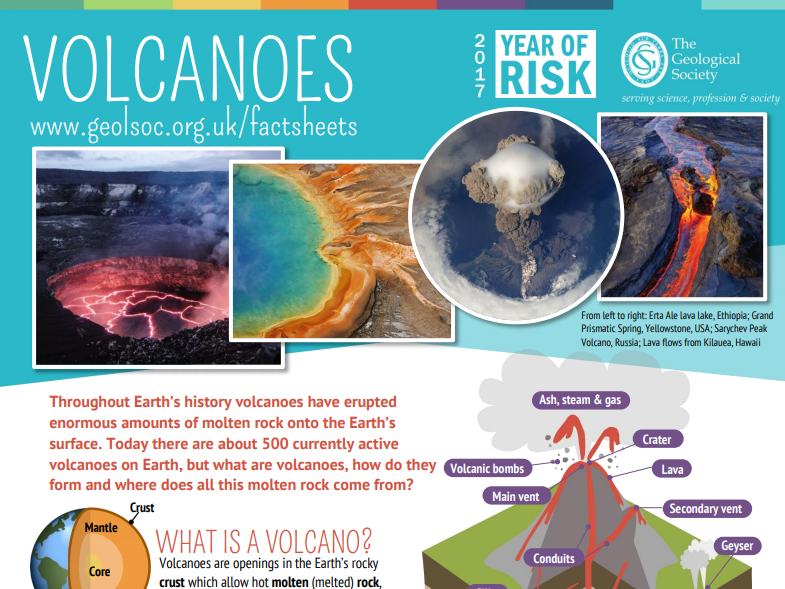
Earthquakes
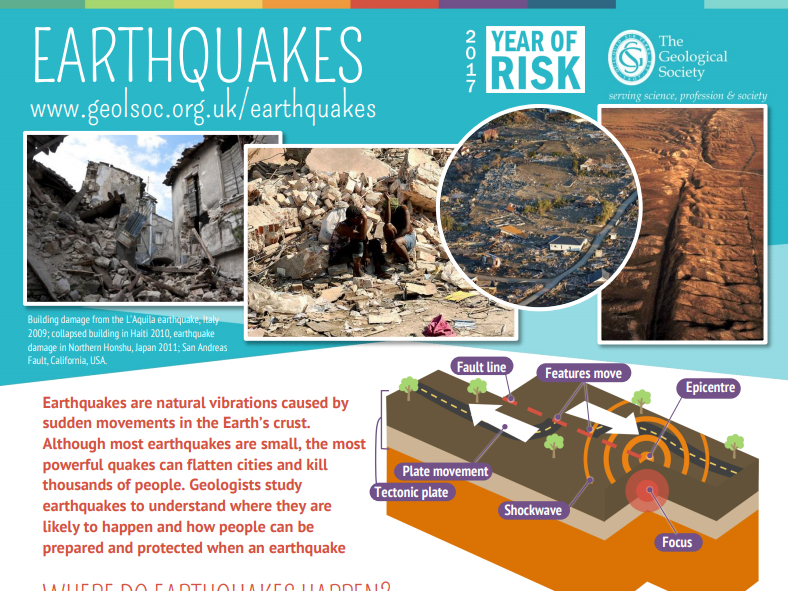
Day 2 – Arizona Geology
Map & Guides
Geologic Map of Arizona
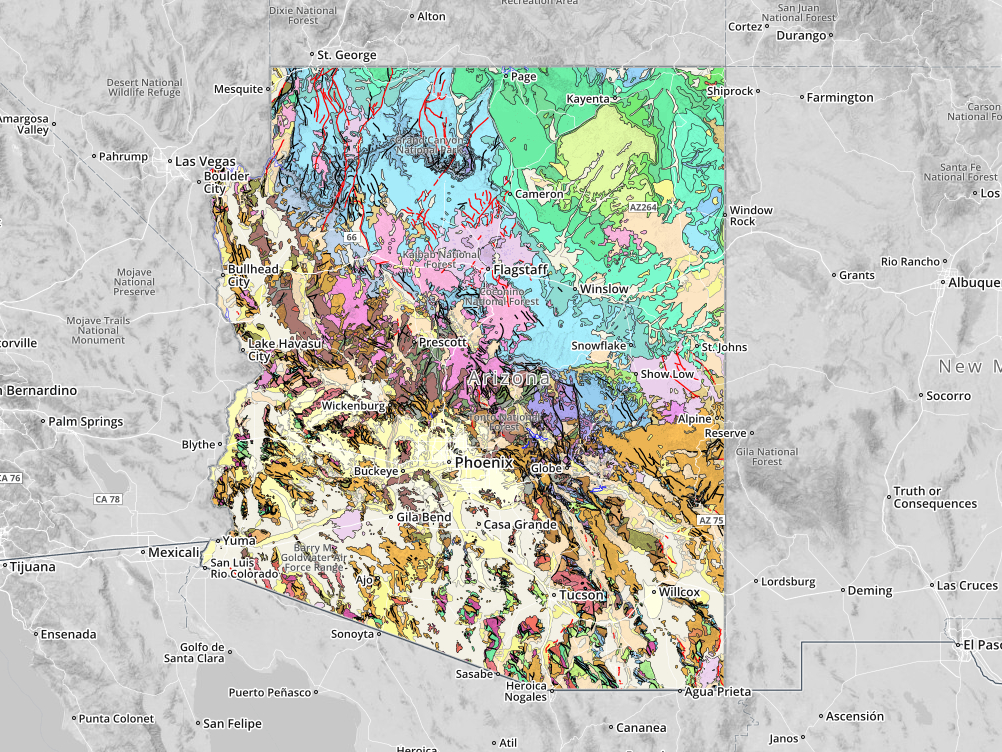
Geologic History of Arizona
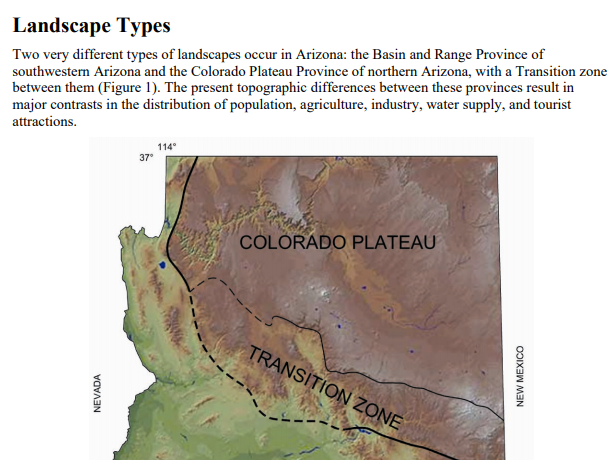
How Rock Is Formed
A Brief History of Geologic Time
How Earth Will Look In 250 million Years
[expand title=”MORE VIDEOS” rel=”fiction”]
Basin & Range Mountain Formation
[/expand]
Kartchner Caverns
In November 1974, Gary Tenen and Randy Tufts were exploring the limestone hills at the eastern base of the Whetstone Mountains. They were looking “for a cave no one had ever found” and found it. The two kept the cave a secret until February 1978 when they told the property owners, James and Lois Kartchner, about their awesome discovery. Since unprotected caves can be seriously damaged by unregulated use, they knew the cave had to be protected. Tenen and Tufts spent several years looking into the possibility of developing the cave themselves. Some members of the Kartchner family lived in Tucson and were very impressed with the development and operation of Catalina State Park by Arizona State Parks. They decided to approach State Parks to see if the agency was interested in acquiring this outstanding resource.
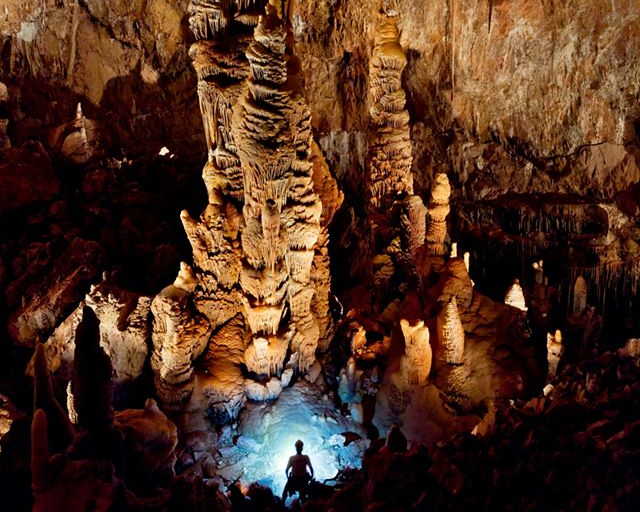
More About Kartchner Caverns From AZPM
At Arizona’s Kartchner Caverns, Science Supports Stewardship — And Vice Versa
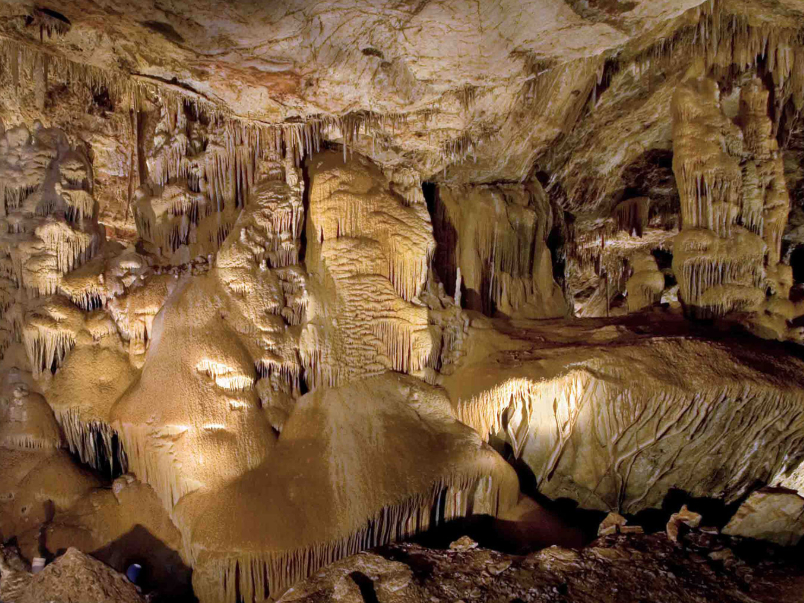
Lights Go Out at Kartchner Caverns, Newest Dark-Sky Park
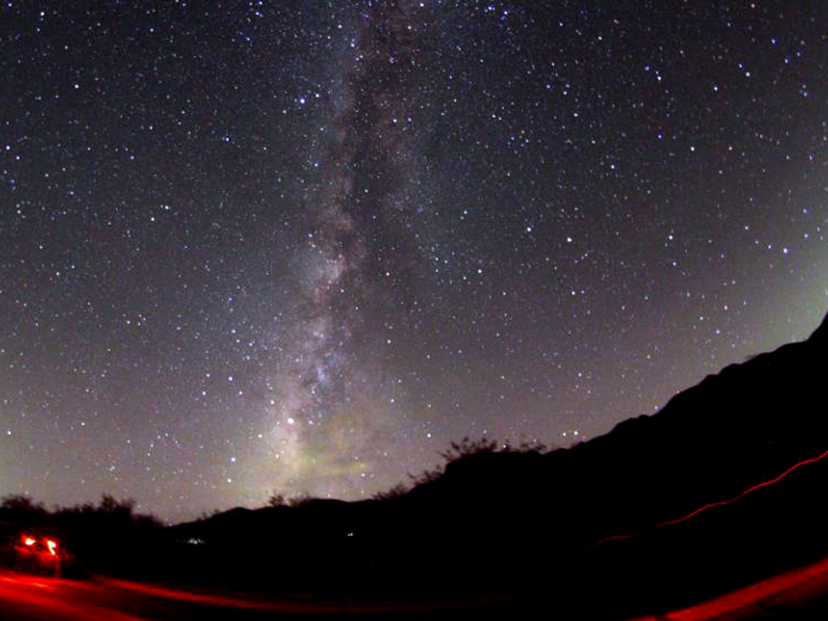
A Tour of Kartchner Caverns with Gary Tenen

Web Feature: What Lies Beneath
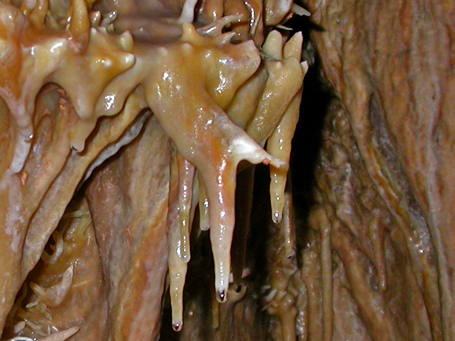
Day 3 – Artistic Expression
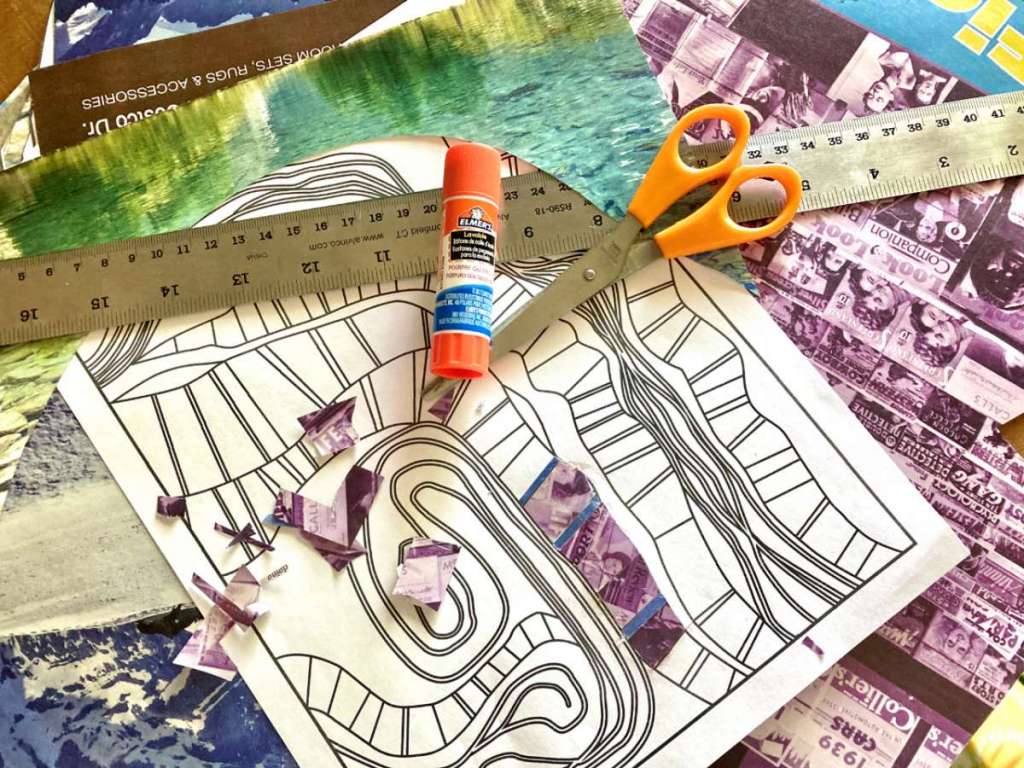
For an additional callenge, try collaging the geology-inspired coloring sheets this week!
Get To Know The Arists
James Burton
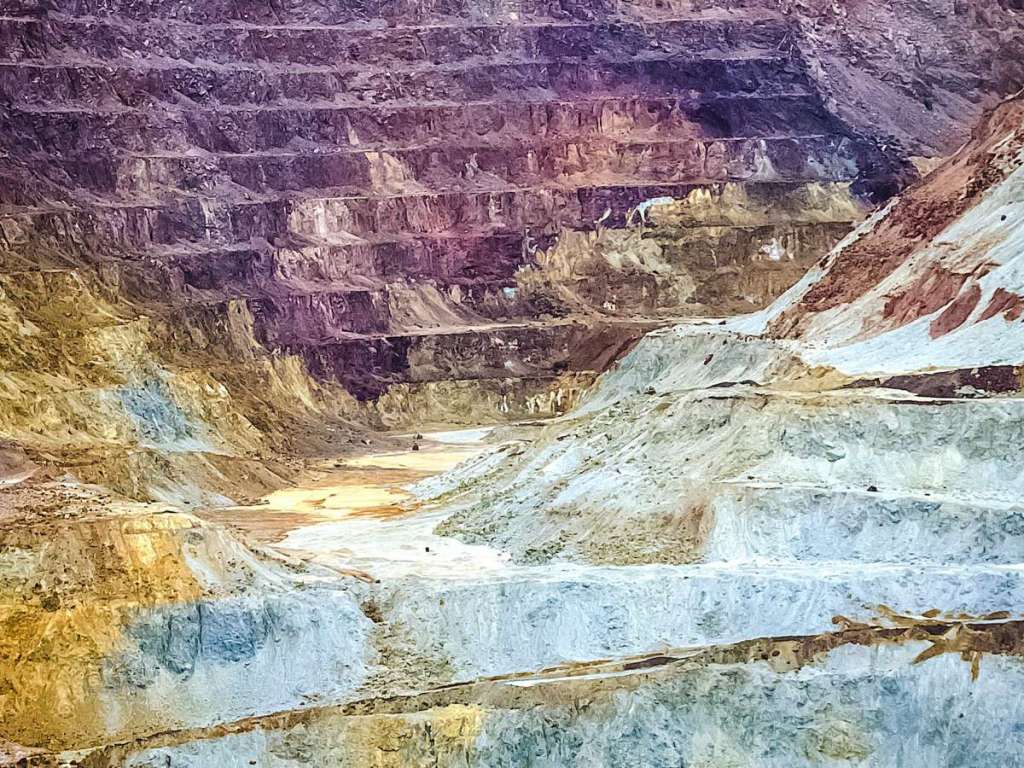
Lavender Pit
“More than a quarter billion (with a “b”!) tons of rock were removed from the Lavender Pit, including almost the whole town of Lowell, Arizona. The pit, even though it is lavender, is named for Harrison Lavender, the mining engineer who conceived the idea of the open-pit mine.”
More
James began using a film camera when he was eight and began doing his own darkroom work as a child. Later, in college in Tempe, Arizona, he fell deeply in love with the American Southwest. His career as a scientist and archaeologist took him across four continents, but Arizona remained, by far, his favorite place on the planet. When James retired in 2015, he returned to Arizona and found time to use a camera again, together with a computer. This has greatly expanded his ability to create images that express how he experiences the desert.
To learn more about James Burton and his work, go to https://jamesburton.zenfolio.com/f543682870
Janet Windsor
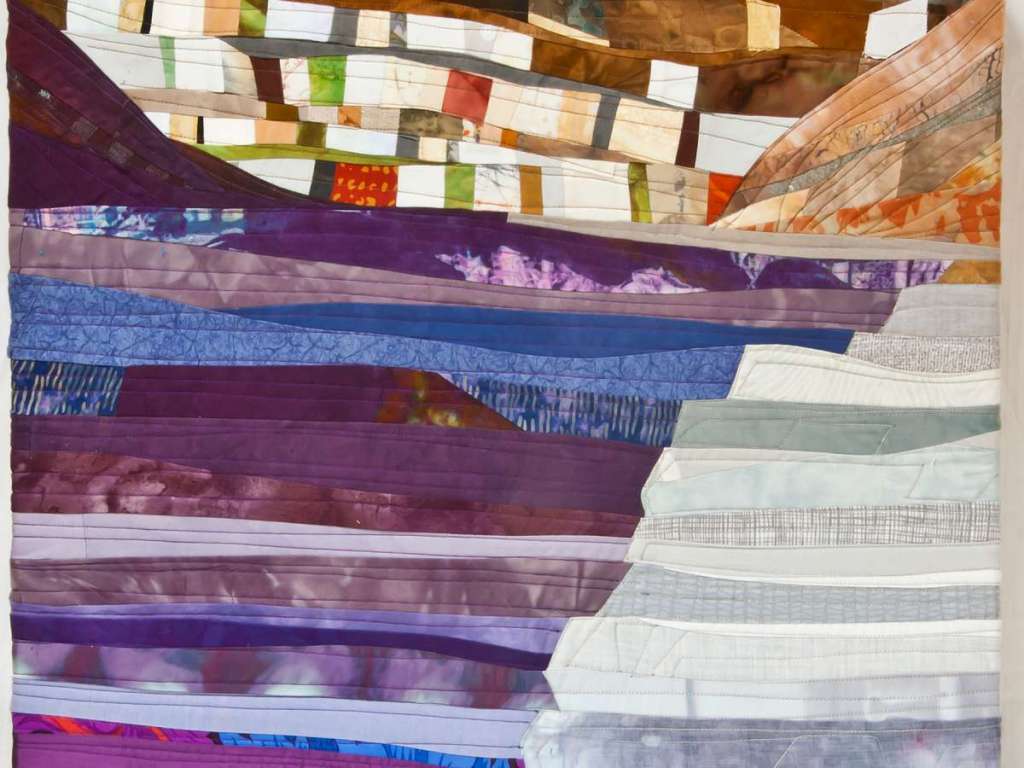
Lavender Pit
“Copper mines are very controversial in Arizona. While they bring in much needed revenue and jobs, they do not leave the landscape untouched. We no longer dig deep into the mountains; we blast them apart, leaving scars upon the land in pursuit of that prized commodity.
More
But, if you look closely, those scars are indeed beautiful, revealing all the layers that lie beneath and each pit is different. The Lavender Pit in Bisbee is aptly named for its beautiful purple layers. And these layers became a quilt.”
I use the desert around me to inspire my works in fabric. The endless variation of color and form lends itself to abstraction in fiber. With this collection, I have branched out in new directions. I have used hand dyeing, embroidery, applique; all of which have been used sparingly, if at all, in my previous work. I have used new materials including wool, tie-dyed velvet and linen, embroidery floss, beads, the better to reveal that hidden beauty inside those dark twisted trees.
To learn more about Janet Windsor and her work, go to http://www.janetwindsor.com/
William Lesch
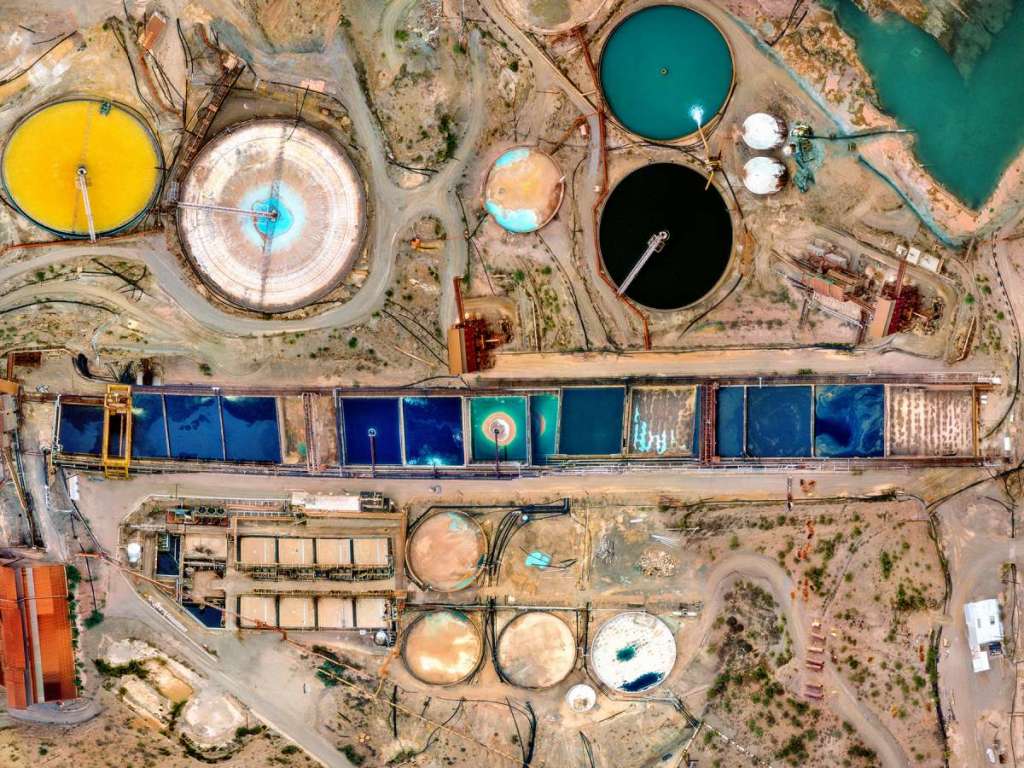
Ray Mine Montage 10
“My aerial photographs were inspired by the aerial work of Emmett Gowin, which I first encountered when he began shooting Mt. St. Helen’s in the late 80’s, and his later work of mines and bomb sites in his book Changing the Earth. The impetus to actually begin taking aerial photographs came
More
about when my son got his pilot’s license in high school in 2001. I began flying with him over Southern Arizona and naturally, I began to photograph from the plane.
We flew over mines and as I looked at them, I understood why Emmett had photographed them. The shapes and colors were amazing, like abstract paintings thrown onto the earth. From the very start, I made the decision not to follow what many other photographers had done with mines and make documentary photos about the destruction of nature. I felt that had been done and besides it seemed too obvious. Of course, these mines were a blight upon the earth, all you had to do was look at them to see that, but they also contained a terrible sort of beauty. They were like road maps of our way of life, the results of the decisions we had made to extract these minerals for our steel and copper, and in their own way, they were huge abstract earth sculptures, the sculpture of our time displayed upon the canvas of the earth.
I made digital scans from the film I shot and once the work was in digital format I realized I could piece these together. I saw no reason I could not work with them like a puzzle, pieces of earth, of shape and color, lines of roads and road cuts, the circles of the open pits and holding ponds. The mines had certainly paid no attention to the earth so I saw no reason to pay attention to factual recording of the mines, if they could move the earth around so could I. The mine photographs are montaged, pieced together from various mines and sections of desert, made into a composition the same way an abstract painter or a mapmaker might work with shapes of color and form.”
William Lesch was born in Indianapolis, Indiana and grew up in the Midwest. His childhood summers were spent on Lake Wawasee in Northern Indiana and it was at Wawasee that he began forming an intimacy with the natural world. Lesch discovered photography and met his future wife, his two life-long loves, in the same year at the age of 21. He took photography as an elective course while in a pre-med program. Lesch had found his calling; he dropped out of pre-med and switched to art the following semester. Lesch earned a BFA in photography from the University of Arizona in 1976. He was the first Staff Photographer at the Center for Creative Photography from 1976-78. It was at this time that he began work on many of his signature series: his first time exposures of clouds, his early color work in the desert, and the beginning of his time-lapse light painting series. William Lesch still resides in Tucson, Arizona. He lives and works in an adobe house and darkroom that he built himself, by hand, making the adobe in his backyard. Lesch has always felt that life and art are about weaving together complex threads, be those threads of color, light and time, or experiences and skills.
To learn more about William Lesch and his work, go to https://www.williamlesch.com/index
Fiona Lovelock
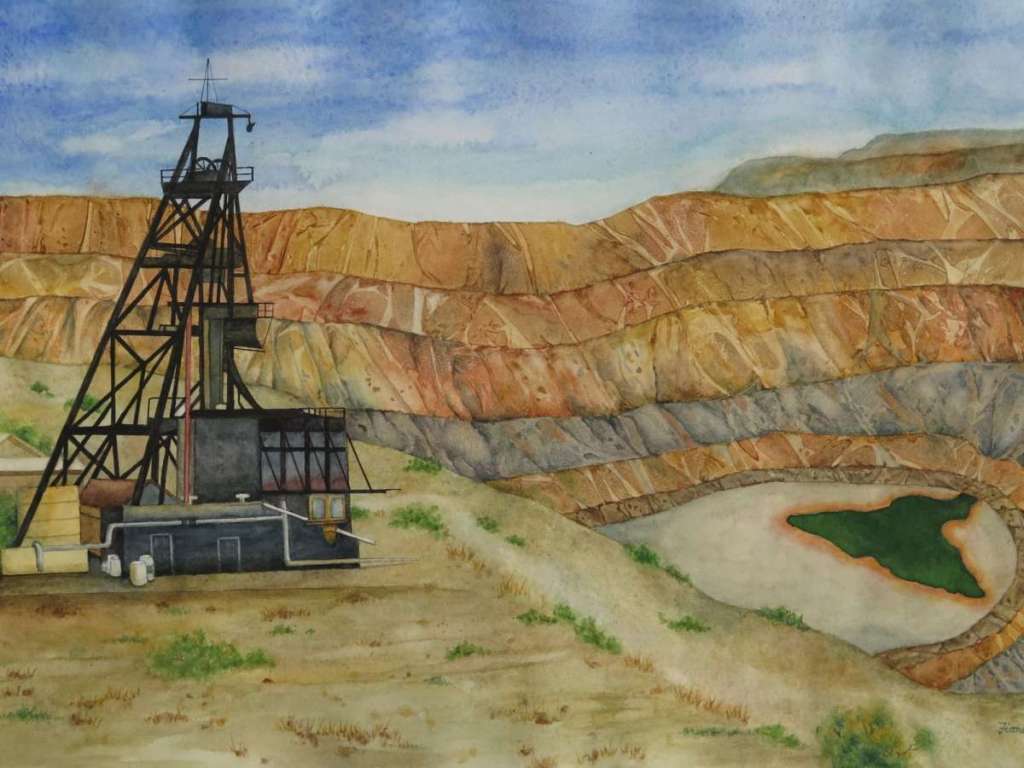
Bisbee Copper Mine
“Bisbee is a very quaint little town with an open pit copper mine. The shaft was used for taking miners down into the depths of the earth. The open pit mine, with its many terraces, is a very colorful sight due to the different soil colors. It was mined mainly for the exceptional quality of copper found there,
More
but it also produced gold, silver, lead, zinc and manganese.”
Fiona was born in Nairobi, Kenya, and lived there until 1965, when she moved to England and married. In 1969, she moved to Canada and lived there until 1974 before making Tucson her permanent home. She has been interested in art, mainly watercolors and drawing, all her life, but only started painting seriously in 1979. She is a signature member of the Southern Arizona Watercolor Guild, the Montana Watercolor Society, Arizona Aqueous, and a member of the Tubac Center of the Arts. Her paintings can be found in collections in the U.S., Canada, England, and South Africa, and have been accepted in numerous juried national and local art exhibitions.
To learn more about Fiona Lovelock and her work, go to http://fionalovelock.com/index.html
Carson Bilger
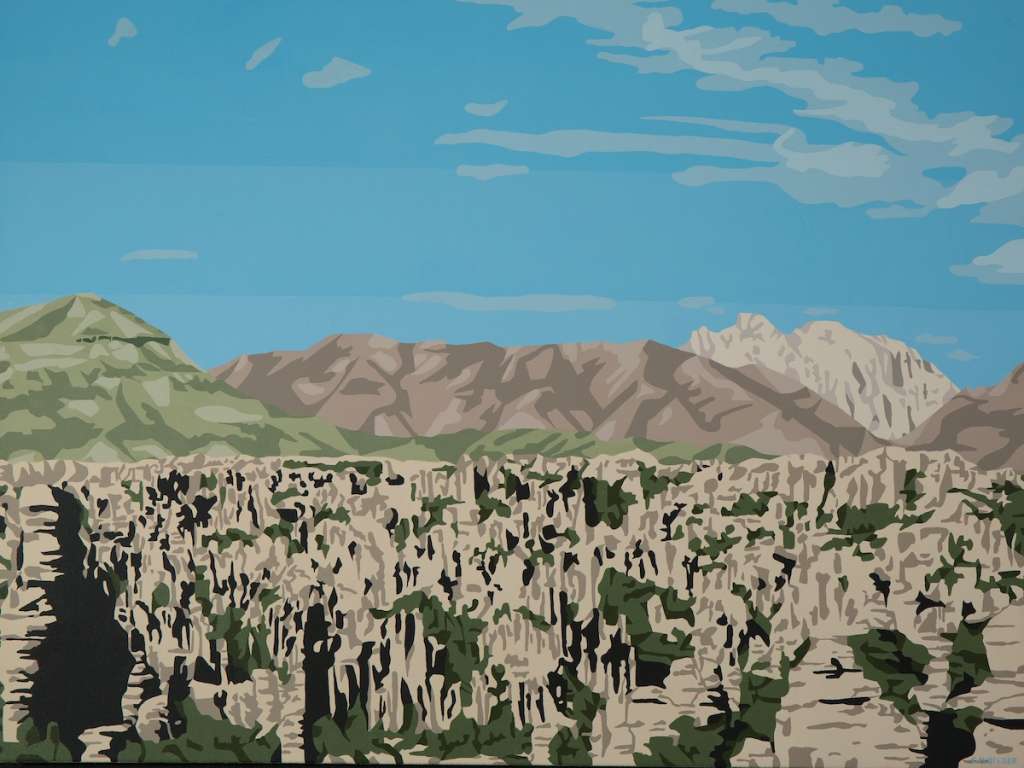
Cochise Head
“This painting shows the mountain that resembles the upward facing head of Cochise in the Chiricahua Mountains. The way the peaks settle into facial features in a way that looks both intentional and natural was strangely beautiful to me.”
More
Carson was born in the Midwest and moved to Arizona as an adult. His artwork is based off his travels around the state and the western part of the country and uses planar analysis to depict these landscapes as a complex puzzle of interlocking shapes and color. His aim is retain the sublime feel of the original location while visually exploring the geometry of spatial relationships.
Carson takes a vintage Polaroid 600 camera on his road trips to capture iconic American landscapes through a nostalgic filter. This imbues the images with a washed out color palette that evokes memory of the landscape as a moment of singular discovery. He then creates watercolor studies in his sketchbook of the photographs, choosing select compositions to paint larger scale using acrylic on canvas or board.
To learn more about Carson Bilder and his work, go to https://carsonbilger.com/
To learn more about the Chiricahua National Monument, visit https://www.nps.gov/chir/learn/nature/geologicformations.htm
Kitty Sturrock
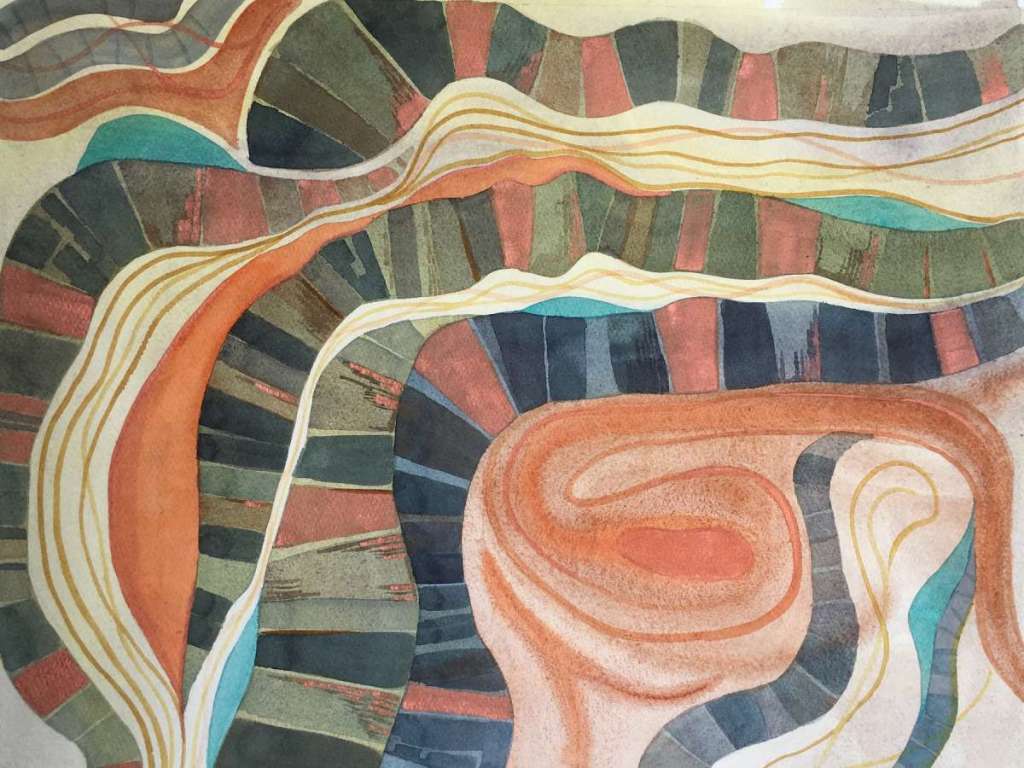
Copper Mine Abstract
“Copper Mine Abstract is an abstract interpretation of a copper mine showing contours, layers, tracks and pools. The work represents hard work, determination and discovery.” Kitty Sturrock is a watercolor artist who spends winters in Arizona and summers in Wisconsin. She finds inspiration
More
on sunny days with dramatic lights and darks. Kitty has been in many juried national exhibits, including Transparent Watercolor Society Annual shows, and Watercolor Wisconsin. She has been juried into top national art fairs including Lakefront Festival of the Arts in Milwaukee, the Old Town Art Fair in Chicago and Art on the Square in Madison, WI. Awards include the Watercolor Wisconsin Purchase Award, Southern Arizona Watercolor Guild Fiesta Sonora Best of Show, Lake Forest Art on the Square Poster Artist, and Featured Artist in the Channel 10 PBS Art Auction. Kitty’s paintings are in collections across the country including the Racine Art Museum permanent collection.
To learn more about Kitty Sturrock and her work, go to https://www.kittysturrock.com/
Day 4 – Artistic Expression, Featured Artists
Tohono Chul Archives
the front side and reverse side of the Original Conceptual Drawing for the Geology Wall | Panel No. 8: UPLIFT AND EROSIAN . Santa Catalina Mountains Region . late Cenozoic Era . (the last 25 million years)
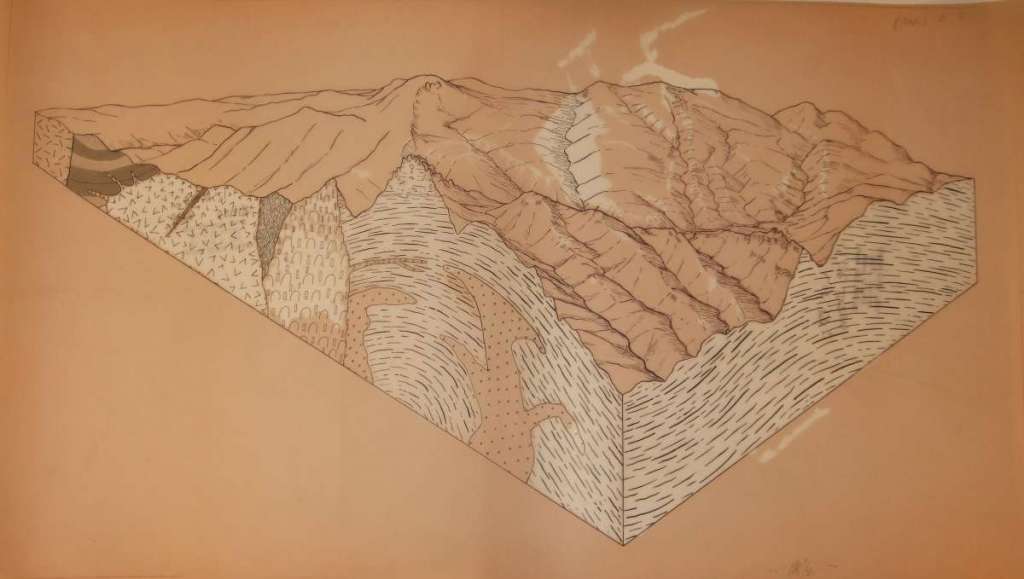
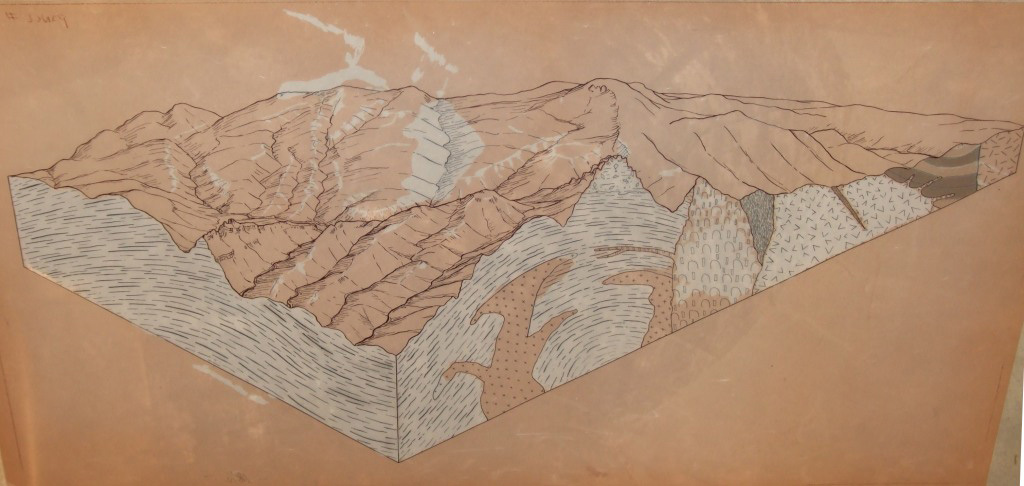
Featured Artists
Carson Bilger
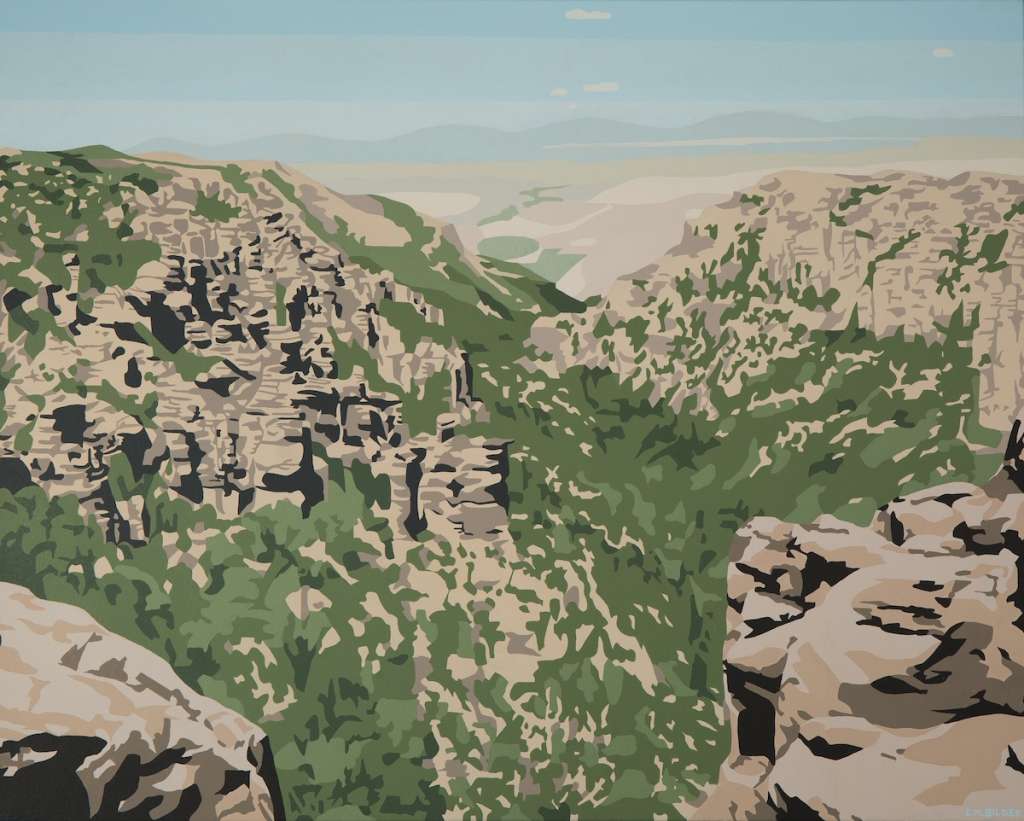
Chiricahua
“Chiricahua was inspired by my first trip to Chiricahua National Monument. I remember driving into the park and being struck by unusual
More
rock formations and mountainous terrain. It was such a strange landscape, and had such an ethereal feel. It was so different than any other place that I’d been to in Arizona. I hiked to Inspiration Point and could see mountain, canyon, and desert all in one vista.”
to learn more about Carson Bilger go to: https://carsonbilger.com/
Fiona Lovelock
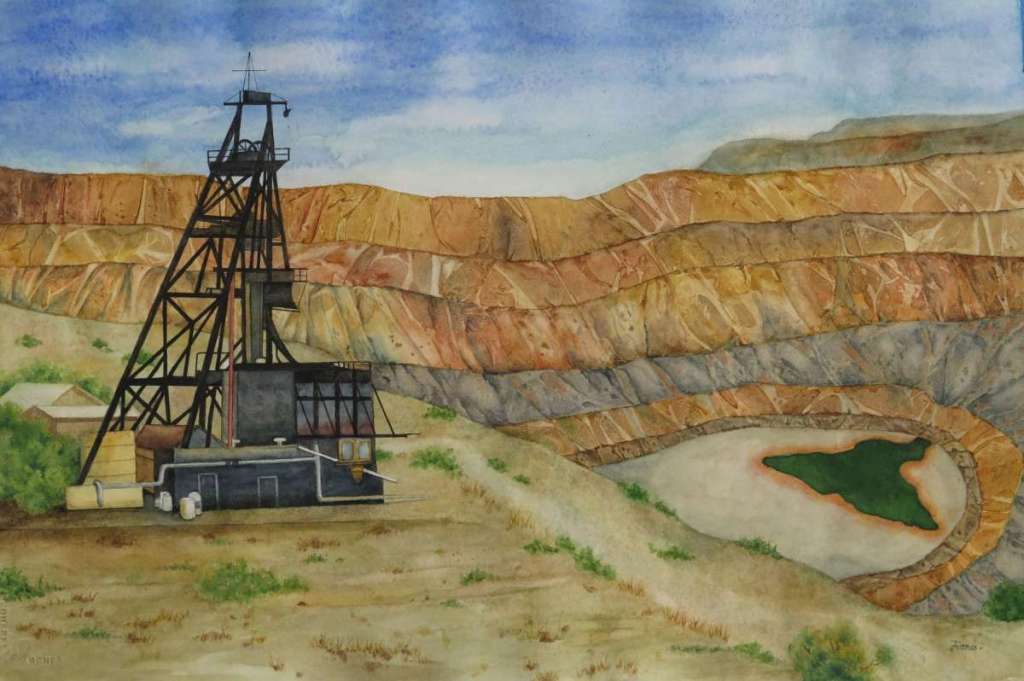
Bisbee Copper Mine
“Bisbee is a very quaint little town with an open pit copper mine. The shaft was used for taking miners down into the depths of the earth.
More
The open pit mine, with its many terraces, is a very colorful sight due to the different soil colors. It was mined mainly for the exceptional quality of copper found there, but it also produced gold, silver, lead, zinc and manganese.”
to learn more about Fiona Lovelock go to: http://fionalovelock.com/
Jerry Cagle
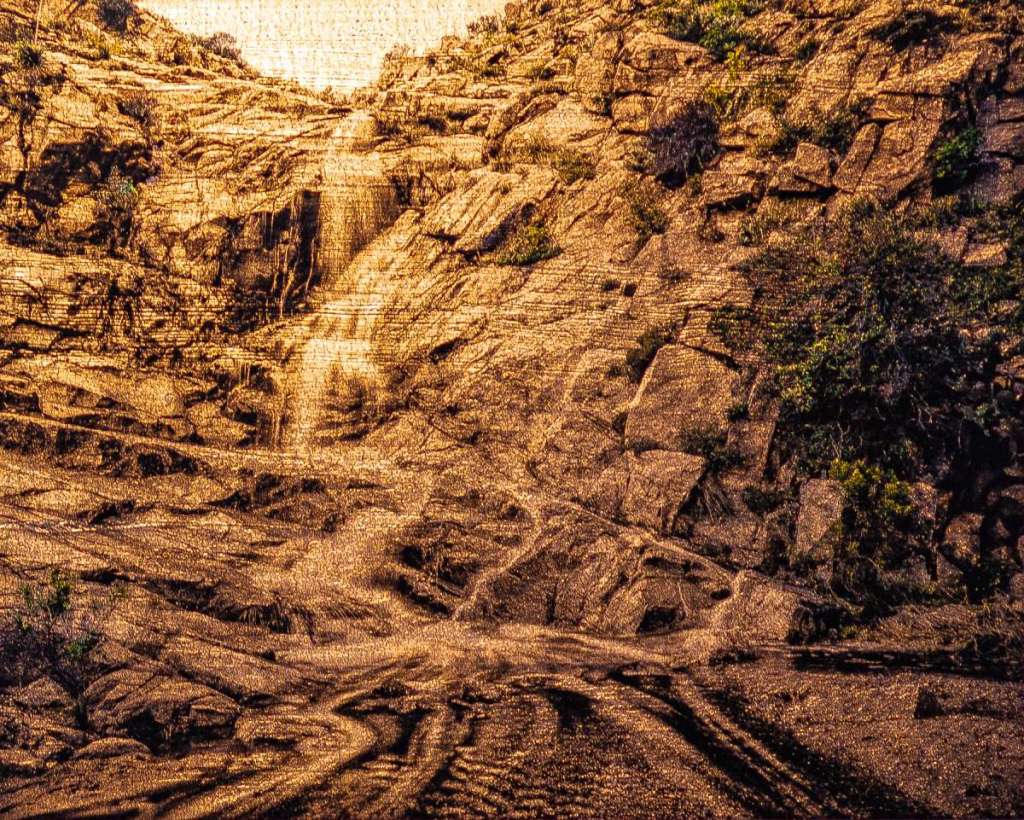
Secret Waterfall
“For almost 5,000 years copper was the only metal known to man. Only 12% of the estimated 5.7 trillion tons of worldwide reserves have been
More
mined since the time of its discovery 10,000 years ago, but, because it is highly recyclable, nearly all of that is still in use.
Copper and water are inseparable. The mining of copper requires enormous quantities of water, and Arizona has very little water but a lot of copper. Is it possible to balance the need for copper and the need for water? In the consumption of copper, we are all complicit – it is in our cars, our cell phones (recycling 1 million cell phones yields 32,000+ pounds of copper!), our computers, our houses – it is in our very bones. Can we reconcile our need for this mineral with the myriad long-reaching adverse consequences of its extraction?”
to learn more about Jerry Cagle go to: https://limbicsystemphotoworks.zenfolio.com/
James Burton
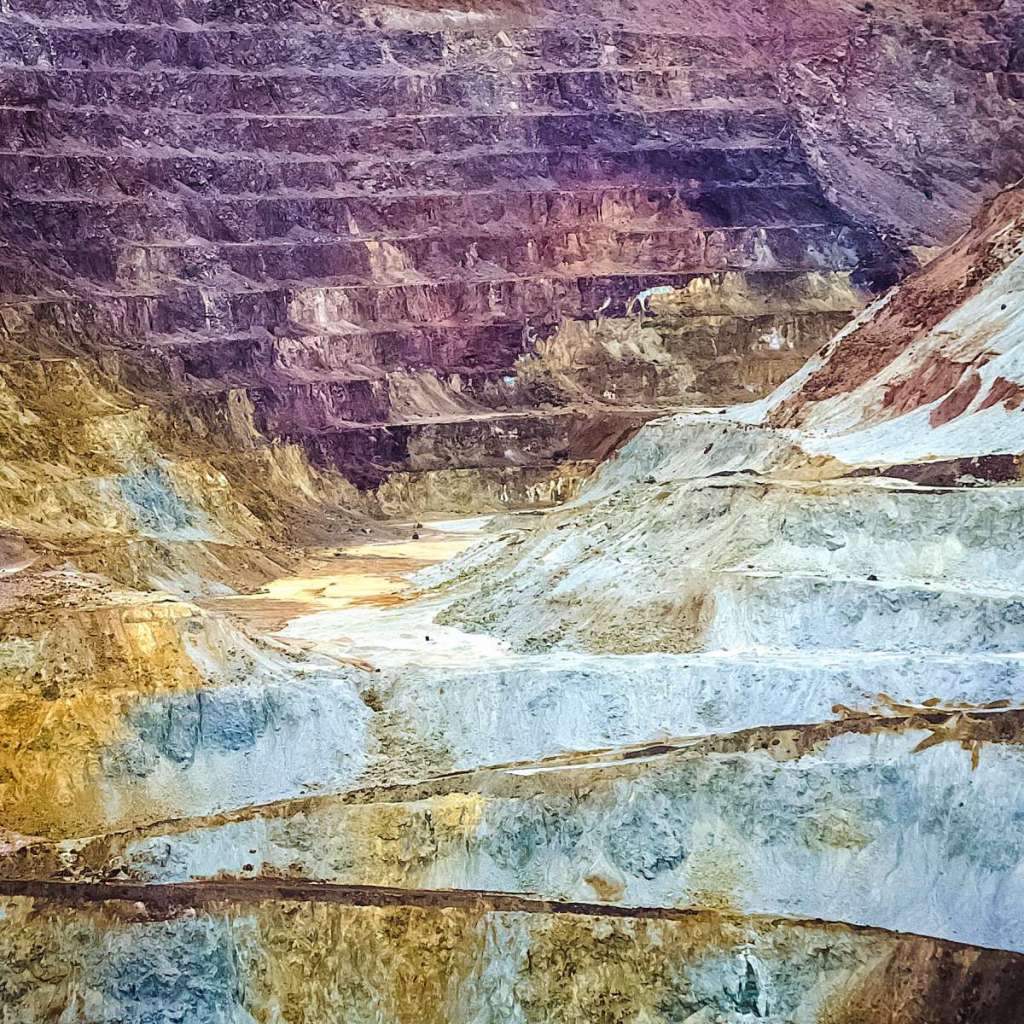
Lavender Pot
“More than a quarter billion (with a ”b”) tons of rock were removed from the Lavender Pit, including almost all of
More
town of Lowell, Arizona. The pit, even though it is lavender, is named for Harrison Lavender, the mining engineer who conceived the idea of the open-pit mine.”
to learn more about James Burton go to: https://jamesburton.zenfolio.com/f543682870
Kitty Sturrock
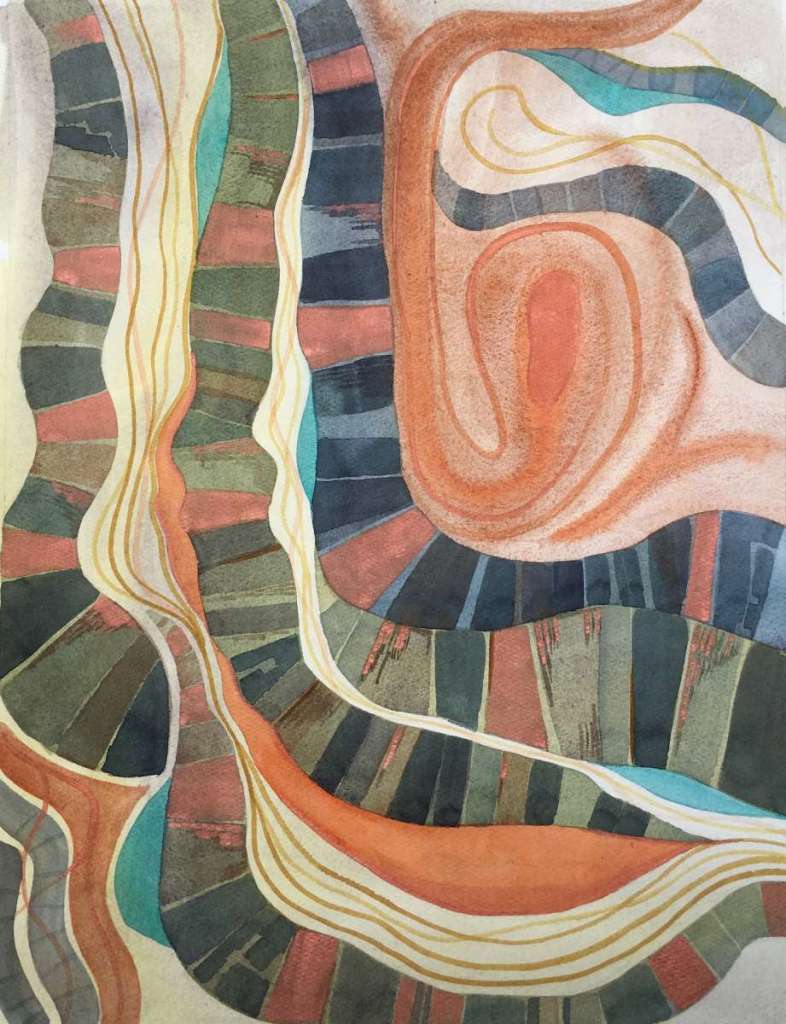
Tom Baumgartner
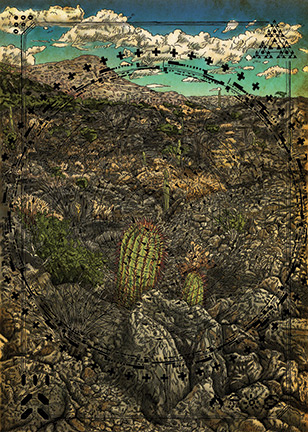
William Lesch
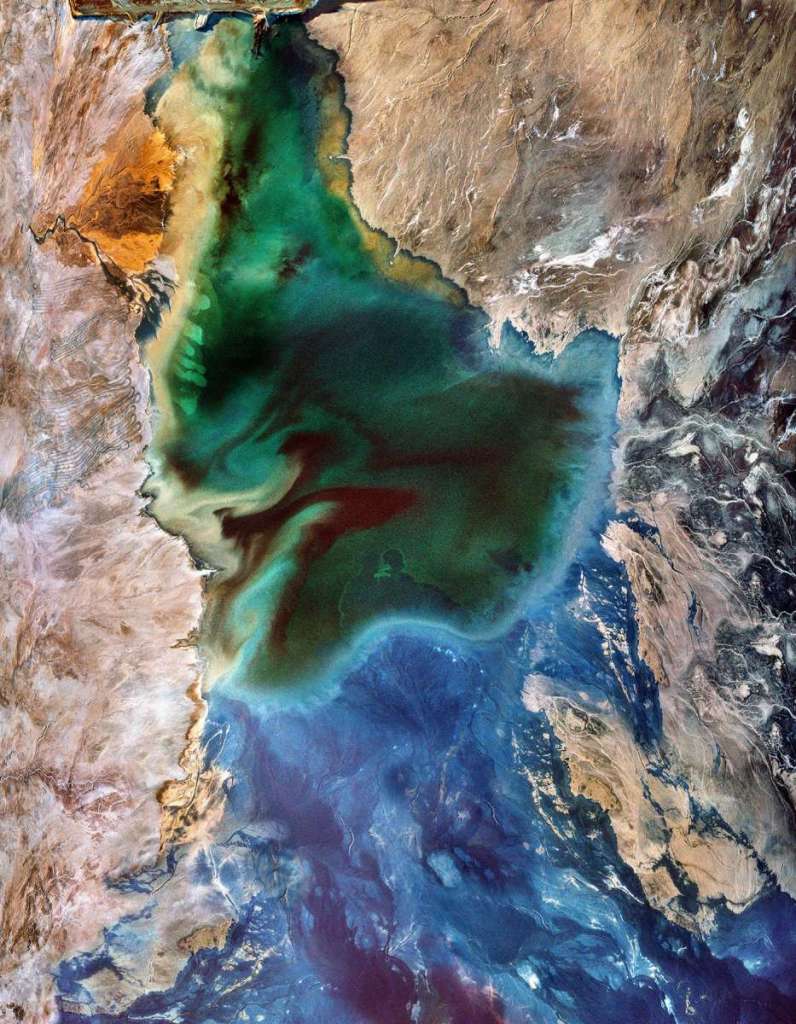
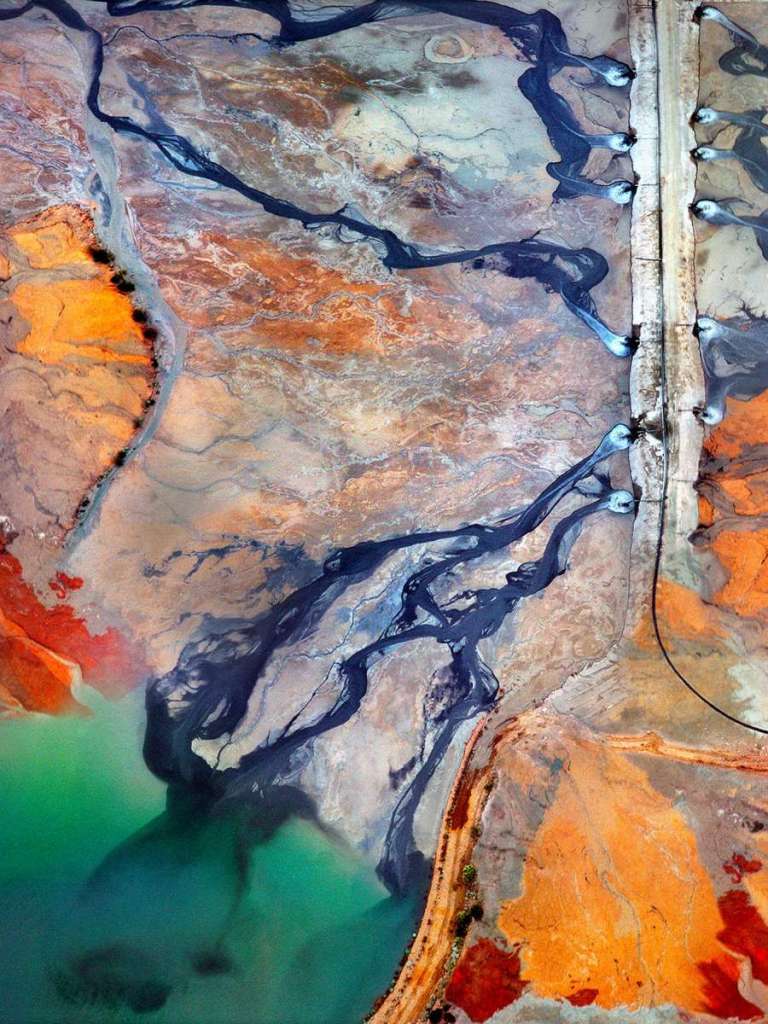
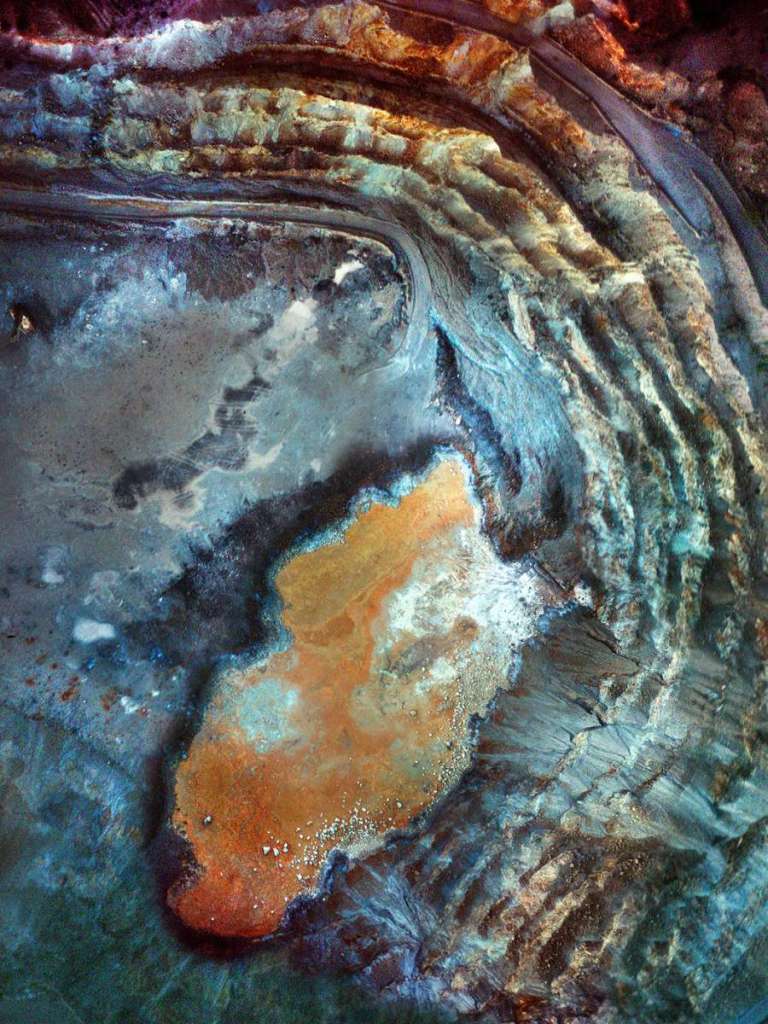
Copper Mine Abstract
AA Pinacatix
Blue Pool no. 27, Sahuarita Mine Tailing Pile
Tailing Pond Abstraction no.22, Ray Mine
Tailing Pond and Open Pit no. 6, Silver Bell Mine
“This watercolor is an abstract interpretation of a copper mine showing contours, layers, tracks and pools. The work represents hard work, determination and discovery.”
More
The open pit mine, with its many terraces, is a very colorful sight due to the different soil colors. It was mined mainly for the exceptional quality of copper found there, but it also produced gold, silver, lead, zinc and manganese.”
to learn more about Fiona Lovelock go to: http://fionalovelock.com/
“The ancient feeling of the Pinacate Bioreserve surrounds you with its volcanic landscape of black cinder. Yet in all of the ancientness, the ʻAʻā (Hawaiian term) or rocky
More
cooled lava looks as though it just happened yesterday. The lava flows are young, as in 40,000 years ago. Once molten and unapproachable, they are still a forbidding place to go if you’re a human.
This piece was about getting into the detail of the rock and being true to its nature. When you get into the details, it’s more like working on an abstract piece. Nature’s abstraction pulls you into the details.”
to learn more about Tom Baumgartner go to: http://patterntology.com/
“These works are part of an extended series of aerial photographs of copper mines in Southern Arizona that I have been working on for the past fifteen years. They were inspired by the aerial work of Emmett Gowin, which I first encountered when he began shooting Mt. St. Helen’s in the late 80’s, and his later work of mines and bombsites in his book, Changing the Earth. The impetus to actually begin taking aerial photographs came about when my son got his pilot’s license in high school in 2001. I began flying with him over Southern Arizona and naturally, I began to photograph from the plane. We flew over mines and as I looked at them I understood why Emmett had
More
photographed them, the shapes and colors were amazing, like abstract paintings thrown onto the earth. From the very start, I made the decision not to follow what many other photographers had done with mines and make documentary photos about the destruction of nature. I felt that had been done and besides it seemed too obvious. Of course, these mines were a blight upon the
Earth, all you had to do was look at them to see that, but they also contained a terrible sort of beauty. They were like road maps of our way of life, the results of the decisions we had made to extract these minerals for our steel and copper, and in their own way, they were huge abstract earth sculptures, the sculpture of our time displayed upon the canvas of the earth.
The photographs were all taken between 2001 and 2006 and printed in 2018. My current prints of these works are made on copper panels coated with white gesso paint that has been aged and dried to expose the copper sheet under the photograph through a veined network of drying cracks in the paint surface. This is done for many reasons, including the visual effect of actual copper veins in a photograph of copper mines. I am interested in the abstract beauty of the mines from the air and how this works with our natural feelings of dismay with how the earth has been gouged and transformed in the process of digging out the copper. We all use copper, from our phones to our computers to the wiring in our homes but the history of our mining of copper is replete with ruined landscapes and blighted areas left after the mining has stopped. I feel it is important to consider these places we have created on the earth, to me they feel like earth paintings that reflect our civilization, both its chaos and its beauty.”
to learn more about William Lesch go to: www.williamlesch.com
Additional Reading
Creating the Canvas: A collaboration between Scott Bennett (Geologist) and Tom Baumgartner (Artist)
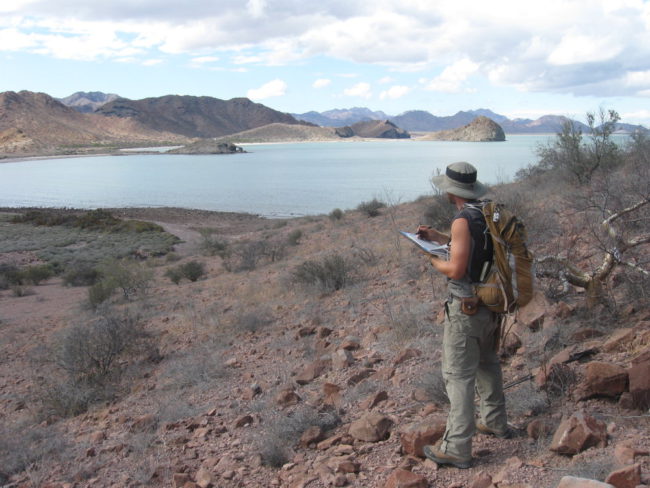
6&6 | Artists and Scientists – A collaboration to explore the patterns and processes
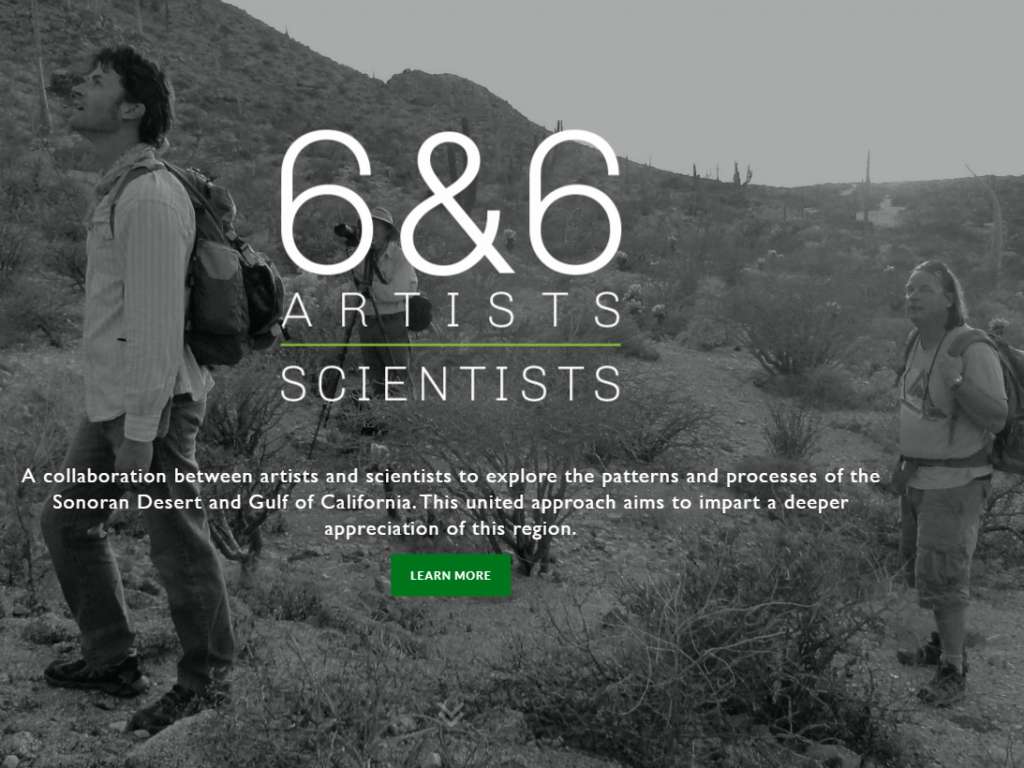
A TERRIBLE BEAUTY: Tohono Chul exhibition looks at the beauty and blight of Arizona Copper
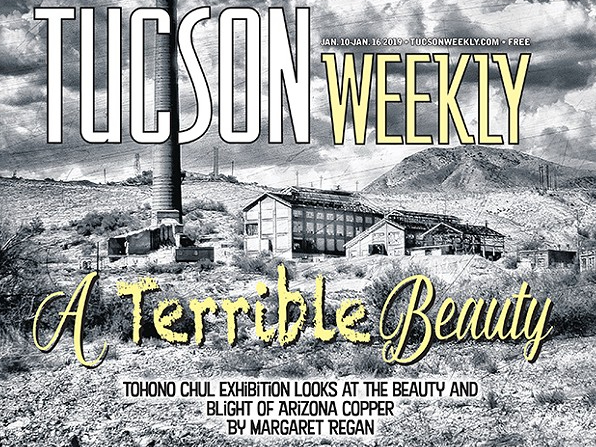
Day 5 – Weekend Inspiration
Rocking Recreation
DIY Rock art! Are you worried you have a black thumb? Try painting these rock cactus plants! Perfectly adapted to our arid environment, you will never need to water them.
11 Easy Rock Painting Ideas for Beginners
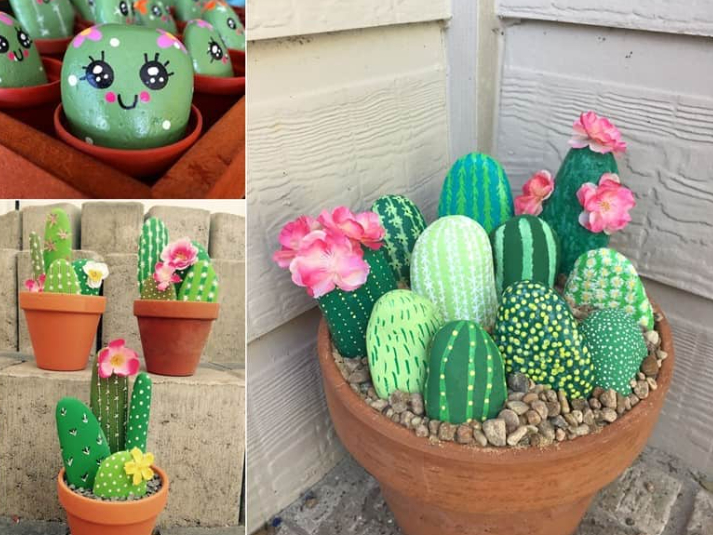
Rock Painting 101 – Enjoy An Easy Step-by-Step
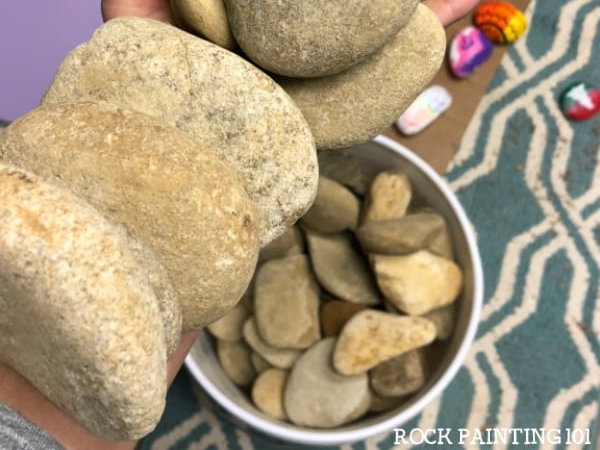
How to DIY Painted Rock Cactus
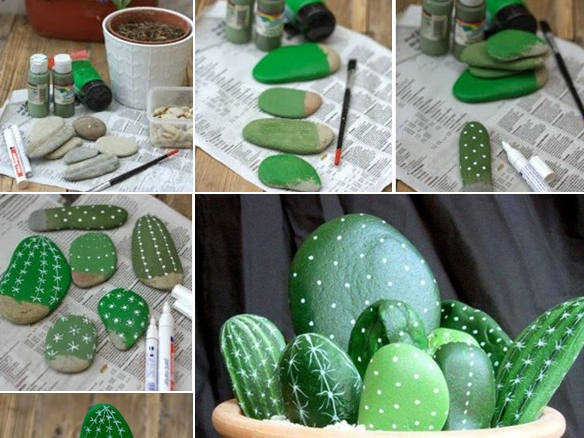
50+ painted rocks that look like succulents & cacti
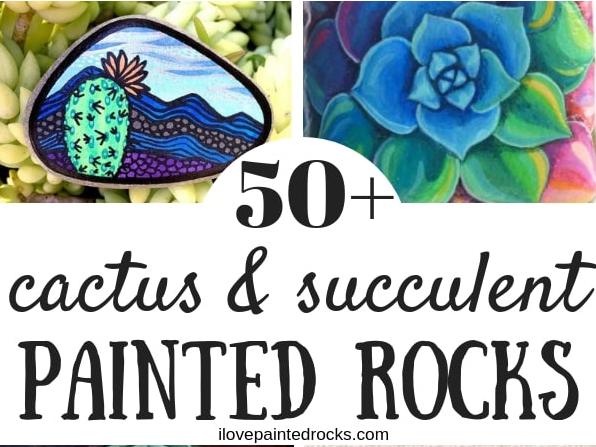
Video Tutorials
Next Week’s Theme
